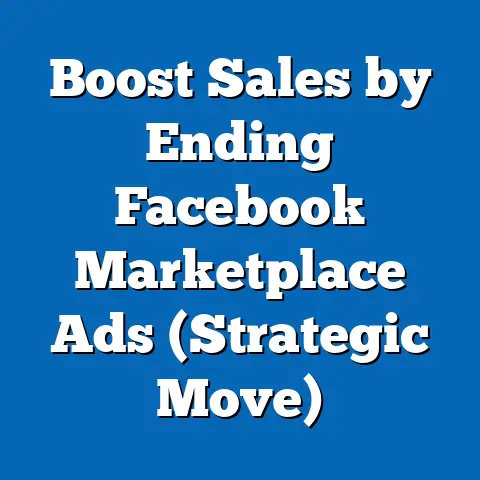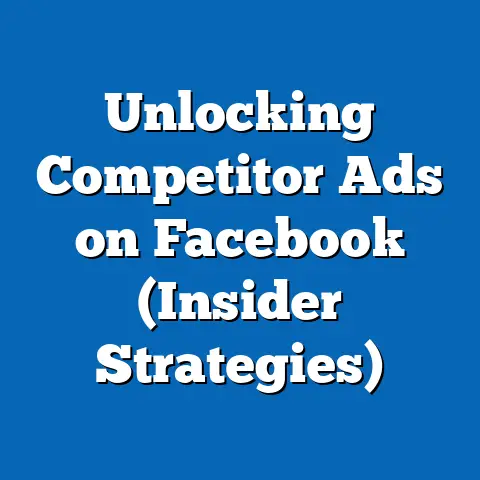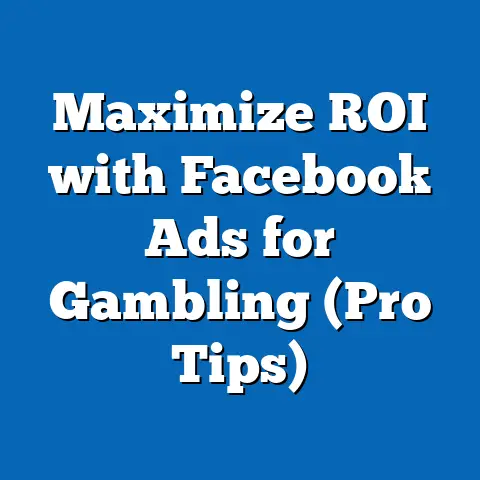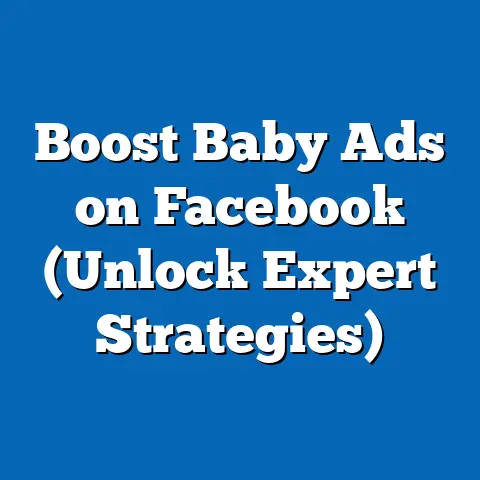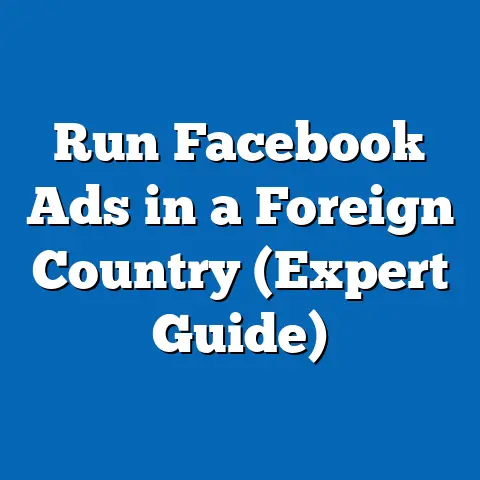Optimize Facebook Ad Creatives (Essential Guidelines)
I’ve seen it happen countless times: a business launches a Facebook ad campaign, brimming with excitement and high hopes, only to be met with a disappointing reality. Low engagement rates, minimal conversions, and a disheartening sense of wasted ad spend. It’s a frustrating experience, like shouting into a void. But what if I told you that the key to unlocking the true potential of your Facebook ads lies in one crucial element: your ad creatives?
Think of it this way: your ad creative is the first impression you make on a potential customer. It’s your chance to grab their attention amidst the endless scroll and convince them that your product or service is worth their time and money. A poorly designed or uninspired ad can easily get lost in the noise, while a well-crafted and strategically optimized ad can be a game-changer.
I remember working with a local bakery that was struggling to attract new customers through their Facebook ads. Their initial ads featured generic images of pastries and bland text. The results were dismal. We decided to completely overhaul their ad creatives, focusing on high-quality, mouth-watering photos of their signature cakes and crafting compelling copy that highlighted the bakery’s unique story and commitment to using fresh, local ingredients. The transformation was remarkable. Their click-through rates soared, their website traffic doubled, and their in-store sales saw a significant boost. It was a testament to the power of optimized ad creatives.
This article is your guide to transforming your Facebook ad campaigns. I’ll walk you through the essential guidelines for creating ad creatives that not only capture attention but also drive meaningful results. Get ready to unlock the true potential of your Facebook advertising efforts and turn your ads into powerful engines for growth.
Understanding the Importance of Ad Creatives
Ad creatives are the visual and textual elements that make up your Facebook ad. This includes everything from the images and videos you use to the headlines, ad copy, and call-to-action buttons. Essentially, it’s the entire package that users see when your ad appears in their newsfeed.
Why are ad creatives so important? Simply put, they are the gateway to user engagement, click-through rates (CTR), and ultimately, conversions. In the crowded and competitive landscape of Facebook advertising, your ad creative is your first and often only chance to make a lasting impression.
- Capturing Attention: Users are bombarded with countless ads every day. A compelling ad creative can break through the noise and grab their attention.
- Driving Engagement: Engaging visuals and persuasive copy encourage users to interact with your ad, whether it’s liking, commenting, or sharing.
- Boosting Click-Through Rates: A well-crafted ad creative entices users to click on your ad and visit your website or landing page.
- Increasing Conversions: Ultimately, the goal of most Facebook ad campaigns is to drive conversions, whether it’s sales, leads, or app installs. Optimized ad creatives can significantly increase your conversion rates by presenting a compelling offer and a clear call to action.
Consider this: according to a recent study by Nielsen, ads with relevant and engaging creatives are 2.4 times more likely to generate a positive brand perception. This underscores the crucial role that ad creatives play in shaping brand image and driving business outcomes.
Takeaway: Your ad creatives are the foundation of your Facebook advertising success. Investing time and effort in optimizing them is essential for achieving your marketing goals.
Key Elements of Effective Facebook Ad Creatives
Now that we’ve established the importance of ad creatives, let’s delve into the key elements that make them effective. I’ve found that focusing on these aspects will give you the best shot at creating ads that convert.
Visual Appeal
In the visually driven world of social media, the visual appeal of your ad is paramount. High-quality images and videos are essential for capturing attention and conveying your message effectively.
- High-Quality Images: Use professional-grade images that are clear, well-lit, and visually appealing. Avoid blurry or pixelated images that can detract from your brand’s image.
- Compelling Videos: Videos are a powerful way to engage your audience and tell your brand’s story. Keep your videos short, engaging, and optimized for mobile viewing.
- Branding and Consistency: Ensure that your visuals are consistent with your brand’s identity, including your logo, colors, and overall aesthetic. This helps to build brand recognition and trust.
I once worked with an e-commerce company that was struggling to generate sales through their Facebook ads. Their initial ads featured low-quality product photos that didn’t accurately represent the quality of their products. We advised them to invest in professional product photography and create visually stunning ads that showcased their products in the best possible light. The results were dramatic. Their ad engagement soared, and their sales increased by over 50%.
Compelling Copy
While visuals are crucial for capturing attention, compelling copy is what ultimately convinces users to take action. Your headlines and ad copy should be persuasive, concise, and relevant to your target audience.
- Persuasive Headlines: Your headline is the first thing users will read, so it needs to be attention-grabbing and compelling. Use strong verbs, numbers, and questions to pique their interest.
- Engaging Ad Copy: Your ad copy should clearly explain the benefits of your product or service and address the needs and pain points of your target audience. Use storytelling techniques to create an emotional connection and make your message more memorable.
- Clear Call-to-Action (CTA): Your CTA tells users what you want them to do next, whether it’s visiting your website, making a purchase, or signing up for a newsletter. Use clear and concise language that encourages immediate action. Examples include “Shop Now,” “Learn More,” and “Sign Up Today.”
I’ve seen countless ads that fail to include a clear CTA, leaving users unsure of what to do next. Don’t make this mistake. A well-defined CTA can significantly increase your conversion rates.
Audience Targeting
Tailored creatives resonate better with specific audiences. Your ad creatives should be relevant to the interests, demographics, and behaviors of your target audience.
- Segmentation: Segment your audience into smaller groups based on their characteristics and create ad creatives that speak directly to their needs and interests.
- Personalization: Use personalized language and visuals that resonate with each audience segment.
- A/B Testing: A/B test different ad creatives for various audience segments to identify what works best.
I once ran a campaign for a fitness studio that was targeting two distinct audience segments: young professionals and stay-at-home parents. We created separate ad creatives for each segment, highlighting the benefits that were most relevant to them. For young professionals, we emphasized the convenience and time-saving aspects of the studio’s classes. For stay-at-home parents, we focused on the family-friendly atmosphere and the opportunity to socialize with other parents. This tailored approach resulted in significantly higher engagement and conversion rates for both segments.
Takeaway: Effective ad creatives are a combination of visual appeal, compelling copy, and audience targeting. By focusing on these key elements, you can create ads that capture attention, drive engagement, and ultimately, achieve your marketing goals.
Best Practices for Optimizing Facebook Ad Creatives
Now that we’ve covered the key elements of effective ad creatives, let’s dive into some best practices for optimizing them for maximum impact. These are the strategies I rely on to consistently improve ad performance.
Utilize Eye-Catching Visuals
Your visuals are the first thing users will see, so they need to be eye-catching and relevant to your ad’s message.
- Choose High-Quality Images and Videos: As mentioned earlier, using professional-grade images and videos is essential. Avoid blurry or pixelated visuals that can detract from your brand’s image.
- Align Visuals with Your Message: Ensure that your visuals accurately represent your product or service and align with the overall message of your ad.
- Use Bold Colors and Dynamic Content: Bold colors and dynamic content can help your ads stand out from the crowd. Experiment with different color palettes and animation techniques to see what works best for your audience.
I’ve found that using images that evoke emotion can be particularly effective. For example, if you’re advertising a travel agency, use images of breathtaking landscapes and happy travelers to inspire wanderlust.
Crafting the Perfect Message
Your ad copy should be concise, impactful, and relevant to your target audience.
- Write Concise and Impactful Ad Copy: Get straight to the point and highlight the key benefits of your product or service. Avoid using jargon or technical terms that your audience may not understand.
- Use Storytelling Techniques: Storytelling is a powerful way to create an emotional connection with your audience and make your message more memorable. Share customer testimonials, case studies, or personal anecdotes to illustrate the value of your product or service.
- Highlight the Benefits, Not Just the Features: Focus on how your product or service can solve your audience’s problems and improve their lives. Don’t just list the features – explain the benefits.
I always try to put myself in the shoes of my target audience when writing ad copy. What are their needs, pain points, and aspirations? How can my product or service help them achieve their goals?
Testing and Iteration
A/B testing is essential for identifying what resonates with your audience and optimizing your ad creatives for maximum impact.
- A/B Test Different Creatives: Test different headlines, ad copy, visuals, and CTAs to see what works best.
- Track Ad Performance: Use Facebook Ads Manager to track the performance of your ads and identify areas for improvement.
- Make Data-Driven Adjustments: Based on your data, make adjustments to your ad creatives to continuously improve their performance.
I typically start by testing two or three different versions of my ad creatives and then gradually refine them based on the results. I also use Facebook’s Dynamic Creative feature, which automatically tests different combinations of ad elements and optimizes for the best performance.
Mobile Optimization
Given that a significant portion of Facebook users access the platform via mobile devices, it’s crucial to optimize your ad creatives for mobile viewing.
- Use Mobile-Friendly Visuals: Ensure that your images and videos are optimized for mobile screens and load quickly.
- Keep Your Ad Copy Concise: Mobile users have shorter attention spans, so it’s important to keep your ad copy concise and easy to read.
- Use Clear and Visible CTAs: Make sure your CTAs are easily visible on mobile screens and encourage immediate action.
I often use Facebook’s Mobile Preview tool to see how my ads will look on different mobile devices. This helps me to identify any potential issues and make necessary adjustments.
Takeaway: Optimizing your Facebook ad creatives is an ongoing process that requires continuous testing, iteration, and adaptation. By following these best practices, you can create ads that capture attention, drive engagement, and ultimately, achieve your marketing goals.
Leveraging Facebook Ad Formats
Facebook offers a variety of ad formats, each with its own unique advantages and use cases. Understanding these formats and leveraging them effectively can significantly enhance your ad campaigns.
- Image Ads: These are the simplest and most common type of Facebook ad, featuring a single image and accompanying text. They are ideal for showcasing products, services, or brand messages.
- Video Ads: Video ads are a powerful way to engage your audience and tell your brand’s story. They can be used to showcase product demos, customer testimonials, or behind-the-scenes footage.
- Carousel Ads: Carousel ads allow you to showcase multiple images or videos in a single ad unit. They are ideal for showcasing a range of products, highlighting different features of a product, or telling a sequential story.
- Slideshow Ads: Slideshow ads are a cost-effective way to create engaging video-like experiences using a series of images. They are ideal for showcasing a product’s features or telling a visual story.
- Collection Ads: Collection ads are designed for e-commerce businesses and allow you to showcase a catalog of products in a visually appealing format. They are ideal for driving sales and increasing website traffic.
- Instant Experience Ads: Instant Experience ads (formerly known as Canvas ads) are full-screen, mobile-optimized ads that provide an immersive and interactive experience. They are ideal for showcasing a product’s features, telling a brand story, or driving app installs.
I’ve found that experimenting with different ad formats is essential for identifying what works best for your target audience and campaign goals. For example, if you’re an e-commerce business, carousel ads and collection ads can be highly effective for showcasing your products and driving sales. If you’re a service-based business, video ads can be a great way to engage your audience and build brand awareness.
Examples of Successful Brands Using Different Ad Formats:
- Nike: Uses video ads to showcase their latest athletic apparel and inspire athletes to push their limits.
- Sephora: Uses carousel ads to showcase a range of beauty products and highlight different features of each product.
- Airbnb: Uses slideshow ads to showcase beautiful vacation rentals and inspire travelers to book their next trip.
Takeaway: Facebook offers a diverse range of ad formats, each with its own unique strengths and use cases. By understanding these formats and leveraging them strategically, you can create more engaging and effective ad campaigns.
Analyzing and Adjusting Your Ad Creatives
The final step in optimizing your Facebook ad creatives is to analyze their performance and make necessary adjustments based on the data. This is an ongoing process that requires continuous monitoring and refinement.
- Monitor Key Performance Metrics: Pay close attention to metrics such as CTR, engagement rate, conversion rate, and cost per acquisition (CPA). These metrics will provide valuable insights into the effectiveness of your ad creatives.
- Use Facebook Ads Manager: Facebook Ads Manager provides a wealth of data and analytics that can help you understand how your ads are performing. Use it to track your key performance metrics, identify trends, and make data-driven adjustments.
- Derive Insights: Analyze your data to identify patterns and trends. What types of visuals are performing best? What headlines are generating the most clicks? What CTAs are driving the most conversions?
- Make Ongoing Adjustments: Based on your insights, make adjustments to your ad creatives to continuously improve their performance. This may involve changing your headlines, ad copy, visuals, or CTAs.
I typically review my ad performance data on a weekly basis and make adjustments as needed. I also use Facebook’s A/B testing feature to continuously test different ad creatives and identify what works best.
Takeaway: Analyzing and adjusting your ad creatives is an essential part of the optimization process. By monitoring your performance metrics, deriving insights, and making ongoing adjustments, you can continuously improve the effectiveness of your Facebook ad campaigns.
Conclusion
Optimizing your Facebook ad creatives is not just about making your ads look pretty; it’s about transforming your entire advertising strategy. By focusing on the key elements of visual appeal, compelling copy, and audience targeting, and by following the best practices of testing, iteration, and mobile optimization, you can create ads that capture attention, drive engagement, and ultimately, achieve your marketing goals.
I encourage you to view your ad campaigns as dynamic projects that require ongoing attention and adaptation. Don’t be afraid to experiment with different ad creatives, test new approaches, and learn from your results. The more you experiment, the more you’ll discover what resonates with your audience and the more successful your Facebook ad campaigns will become.
So, take action today. Implement these essential guidelines, experiment with your ad creatives, and watch as your Facebook advertising efforts transform from a source of frustration to a powerful engine for growth. The results may surprise you.

